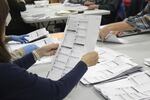Oregonians are in no rush to vote this year, despite an election season that could profoundly reshape the state’s governance structure and representation in Congress.
Whether the slow start means fewer people will actually vote this year than comparable cycles remains to be seen. This marks the first general election in which Oregonians have the ability to drop their ballot in the mail on Election Day and still see it count, thanks to a law passed in 2021.
As of Monday morning, state elections officials reported 36% of voters had returned their ballots this year. While the tally is certain to increase a lot by the end of Monday, it’s unclear that voters will be on pace to match or exceed turnout in the past two mid-term elections in 2018 and 2014.
In both of those years, just under 50% of voters had handed in ballots on the eve of Election Day. In 2018, 67.8% of voters wound up turning in ballots. In 2014, turnout was 69.5%.

FILE - An election worker examines a ballot at the Clackamas County Elections office on May 19, 2022, in Oregon City, Ore, in Oregon's primary election.
Gillian Flaccus / AP
Voters have held onto their ballots longest in Multnomah County, the state’s most populous county and its major Democratic stronghold. As of early Monday, roughly 31% of ballots had been returned in the county, the lowest turnout rate in the state. That number ticked up a bit by mid-morning, to 32.4%.
Multnomah County Elections Director Tim Scott noted last week that voters in the county have a lengthy ballot, with a bevy of county and city ballot measures crowding around major contests for governor, Congress and local office. That could be spurring voters to push off handing in their ballots while they decide how to vote, he said.
“I think we’re going to get more ballots late,” Scott said last week. “That’s pretty typical in a gubernatorial election.”
Even so, Scott noted that turnout has lagged in the county this year, compared to other recent mid-terms. That could be in part because of a new law that political observers are uncertain how to incorporate into their analyses.
Last year, lawmakers altered voting rules so that mailed ballots can be counted up to a week past the election, so long as they are postmarked by Election Day. That law appeared to delay ballot returns in this year’s May primary, when what initially appeared like it would be a low-turnout election instead proved to be relatively strong for a mid-term year, with 37.8% of registered voters returning ballots.
The strength of turnout in the final two days will be pivotal in determining a slate of races that have turned a national spotlight on Oregon in recent weeks.
At the top of the ticket, former House Speaker Tina Kotek is trying not to become the first Democratic nominee to lose a governor’s race in the state since 1982. But she’s been tested by Republican Christine Drazan, a former state lawmaker whom polling has shown running even with Kotek. Unaffiliated candidate Betsy Johnson, a former Democratic state senator, is pulling more voters away from Kotek than Drazan, according to polls.
With the race likely to come down to who can whip up the most enthusiasm, Kotek and Drazan have been campaigning ceaselessly. Drazan flew around the state over the weekend, holding rallies in airports and urging her supporters to turn in ballots.
“Vote, vote, vote,” Drazan told a crowd in Salem. “We can turn the state around together, but only if we do this work together. Let’s get this done.”
Kotek, meanwhile, held a rally at Revolution Hall in Portland, featuring Democratic members of the state’s Congressional delegation and a performance by the band Portugal. The Man. Democrats have said they will tap a historic party strength, knocking on doors to convince their voters to participate, in order to bring the race home.
Some prognosticators think that effort will prove potent. The Center for Politics at the University of Virginia, a major player in national political analysis, changed its rating of the race from “toss up” to “lean Democrat” on Monday, relying partially on Democrats’ healthy registration advantage in the state. Other forecasters believe the race is still too close to call.
Registered Democrats outnumber registered Republicans in Oregon by more than 280,000. But as of Monday morning, the GOP had been quicker to turn in their ballots, with 48.3% of Republicans voting versus 43.7% of Democrats. That still amounts to a Democratic advantage of more than 90,000 votes.
While the governor’s race has seen most attention, plenty more is up in the air on Tuesday. The state has three competitive races for the U.S. House that could see Oregon Republicans expand their influence in Congress. And the GOP has plans to make gains in both the state House and Senate, with the potential of taking at least a share of leadership in the Senate.
